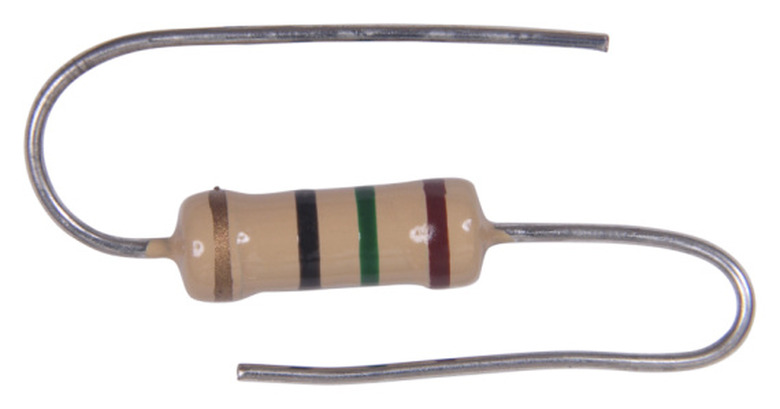How To Wire Resistor Load In LED Lights
LED (light emitting diode) lights are low-current electronic components. As such, they cannot be connected directly to a typical household battery without running the risk of burning out from too much current. To prevent a single LED (or chain of LEDs) from burning out, a resistor load is placed in the circuit to limit the amount of current that flows through the LED(s). Typical LEDs operate within a range of a few milliamps of current and under 3 volts of direct current power from a battery. A resistor load of approximately 100 ohms will prevent a common 5 mm red LED from burning out.
Step 1
Tin a 100-ohm resistor and a red LED by melting solder over their leads.
Step 2
Solder one lead of the resistor to the short lead of the red LED. Resistors are non-polar, so either end will do. LEDs, however, are polar; therefore, polarity must be observed in the connections. The short lead of the LED is the cathode (negative) lead.
Step 3
Solder one end of a copper wire to the remaining resistor lead. Solder one end of a second copper wire to the long lead of the red LED. The long lead is the cathode (positive) lead of the LED.
Step 4
Hold the negative side LED/copper wire to the negative terminal of a 1.5 to 3.0 volt battery. Hold the positive side LED/copper wire to the positive terminal of the battery. The red LED will light and will not burn out.
Things Needed
- 100-ohm resistor
- 1.5- to 3.0-volt battery
- 5 mm red LED rated at 28 milliamps
- Rosin core solder
- Soldering iron
- 2 6-inch lengths of copper wire
TL;DR (Too Long; Didn't Read)
Vary the values of resistor used. Larger resistors will cause the LED to glow dimmer. Smaller resistors will cause the LED to glow brighter. However, too small of a resistor (or too large of a battery) will cause the LED to get hot and burn out.
Warning
Soldering irons are hot enough to cause severe 3rd degree burns; use with caution when soldering.
Avoid breathing in the fumes from the melting solder. Solder fumes contain traces of lead, a known neurotoxin.
References
- "Understanding Basic Electronics"; Larry D. Wolfgang; 2006
- "Getting Started in Electronics"; Forrest M. Mimms, III; 1991
Cite This Article
MLA
Boyer, Timothy. "How To Wire Resistor Load In LED Lights" sciencing.com, https://www.sciencing.com/wire-resistor-load-led-lights-8596614/. 24 April 2017.
APA
Boyer, Timothy. (2017, April 24). How To Wire Resistor Load In LED Lights. sciencing.com. Retrieved from https://www.sciencing.com/wire-resistor-load-led-lights-8596614/
Chicago
Boyer, Timothy. How To Wire Resistor Load In LED Lights last modified March 24, 2022. https://www.sciencing.com/wire-resistor-load-led-lights-8596614/
